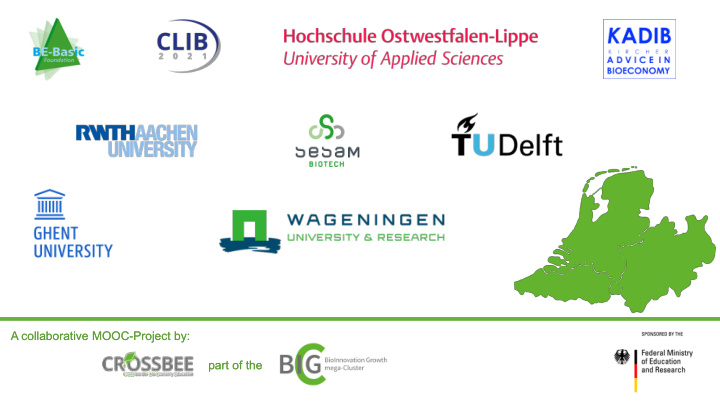



A collaborative MOOC-Project by: A collaborative MOOC-Project by: part of the part of the
Sustainable biopolymers Production, applications and future directions Lars M. Blank A collaborative MOOC-Project by: part of the
Challenges of the bioplastic life cycle Lars M. Blank A collaborative MOOC-Project by: part of the
Worldwide polymer/plastic production 2015 393 Mt global 2010 polymer 322 Mt production 3 global plastic production 4 275 Mt 270 Mt 2010 total global plastic plastic 6,350-245,00 t 2 waste production 1 99.5 Mt 2017 coastal estimated plastic plastic waste floating at the 31.9 Mt waste ocean surface coastal 2.05 Mt mismanaged bio-plastic plastic waste 8 Mt production 5 plastic waste goes into the see Adapted from Jambeck et al., Science 2015; Data origin: 1 Plastics Europe, „Plastics – The Facts 2013“; 2 Cozar et al., 2014; Erikson et als., 2014; 3 European Bioplastics, nova-Institute 2015; 4 Plastics Europe, „Plastics – The Facts 2016“; 5 European Bioplastics, nova-Institute 2017
Recent bioplastics global production capacities 3000 forecast 2440 total capacity 2048 2054 2028 biodegradable 2000 1086 1697 1581 in 1000 t 757 737 bio-based/ 880 non-biodegradable 663 591 1000 1354 1291 1291 1174 1034 990 0 2013 2014 2015 2016 2017 2022 data: European Bioplastics, nova-Institute (2017)
Bioplastics global production capacities, 2017 starch blend PET PHA PA Starch blend PLA PE PET 18.8 % 26.3 % PBS Other PHA 2.4 % (biobased/ PBAT non-biodegradable) Total: other PLA 2.05 million (biodegradable) 10.3 % tons PA 11.2 % PBS 4.9 % PE 9.7 % biodegradable biobased/ PBAT 5 % 42.9 % non-biodegradable other 1.5 % 57.1 % other 9.2 % data: European Bioplastics; nova-Institute (2017)
Life cycle of bioplastics Closing the loop product bioplastic production manufacturing biotechnology & chemistry reduction of reuse use • oil dependence • greenhouse gas emission • waste EU28+2, 2008 • plastic waste – 24.9 Mt • packaging plastic waste – 63 % feedstock disposal data: European Commission DG Environment
Waste-management strategies • closed-loop recycle plastic or • downcycling product mechanical reuse • upcycling production recycling landfill chemical feedstock/ • by heat recycling monomers • chemically • enzymatically energy electricity recover • incineration heat
Recycling rates – Europe and worldwide 2014, 25.8 mt 29.7 % 39.5 % 30.8 % EU28+2 of plastics waste is recycled is incinerated is landfilled 2013, 78 mt 10 % 14 % 32 % 40 % worldwide of plastics waste is recycled Incineration or leakage is landfilled (14 % collected) energy recovery data: PlasticsEurope, “Plastic – The Facts 2016”; Ellen MacArthur Foundation, “The new plastics economy, 2016”
Collecting rates of PET-bottles, 2016 plastic recycling process collecting 2016 sorting 28.4 % shredding 59.8 % pellet making 93.5 % re-using data: GVM, 2016; NAPCOR, 2016; Petcore Europe, 2016; picture: greensutra.in
Plastics have several lives outdoor elements building & construction 32.1 % new PET bottles 2013 recycled plastic 93.6 % clothes & bags & used to recycling 29.4 % footwear packaging manufacture textile fiber industry new products 27.3 % furniture automotive film industry 11.2 % other applications photos: PlasticsEurope; data: GVM – Gesellschaft für Verpackungsmarktforschung
Use of biopolymers can reduce the carbon footprint life cycle assessment for lactic acid/lactide production process in Thailand – cradle to gate 307 kg CO 2 92 kg CO 2 4 kg CO 2 609 kg CO 2 CO 2 CO 2 capture/ emissions avoided emissions -164 kg CO 2 -1467 kg CO 2 lactide sugarcane fields lactide customers sugar mill 26 kg CO 2 plant 369 kg CO 2 total carbon footprint -224 back to agriculture by-products as soil conditioner kg CO 2 per ton lactide mining burning lime limestone limestone source: www. corbion.com
A collaborative MOOC-Project by: A collaborative MOOC-Project by: part of the part of the
Recommend
More recommend